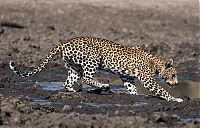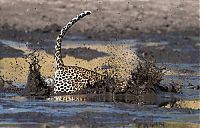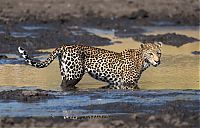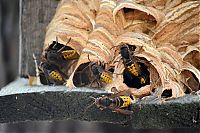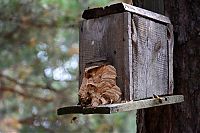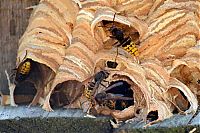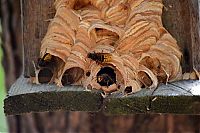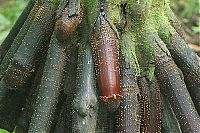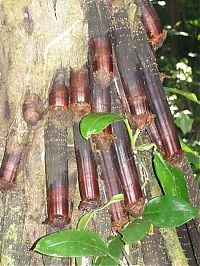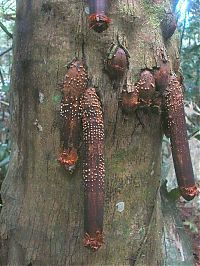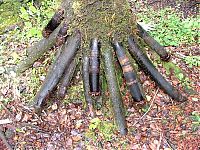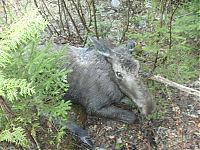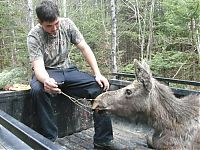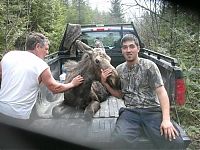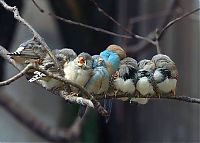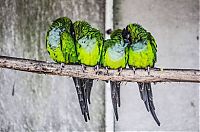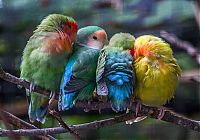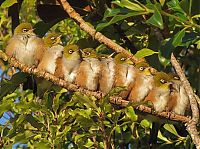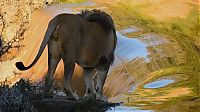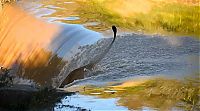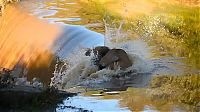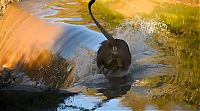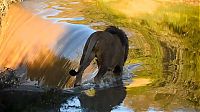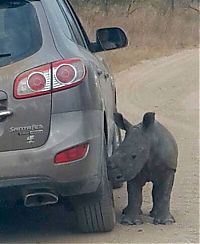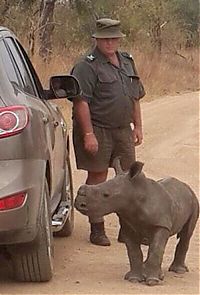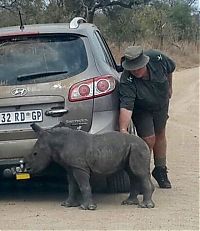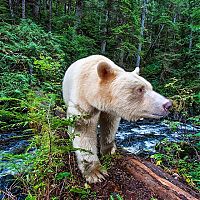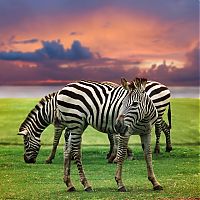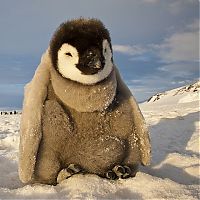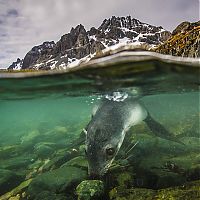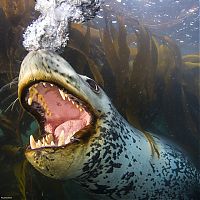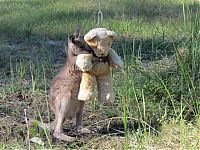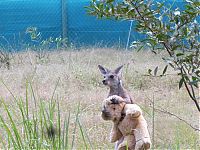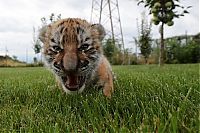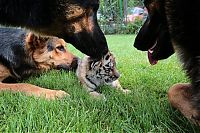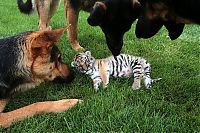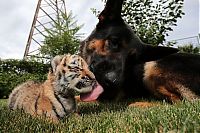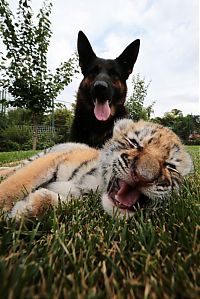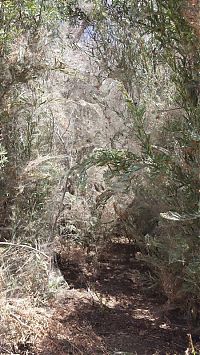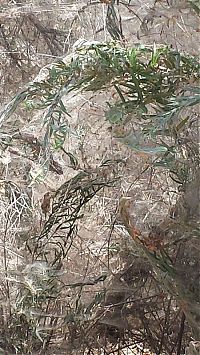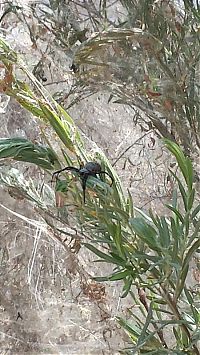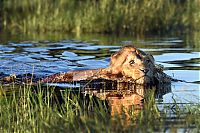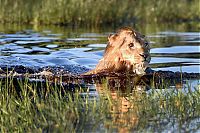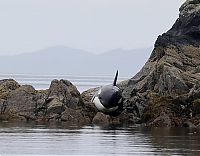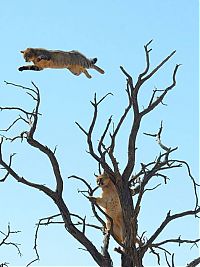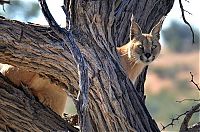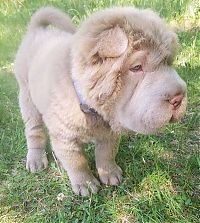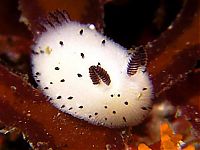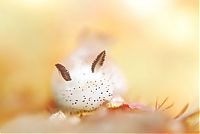Leopard Fishing In The Mud
Monday, 7th September 2015, 22:22:13
Album: Fauna & Flora, New uploads: 3, Hits: 349, Size: 0MiB
The leopard, Panthera pardus, is a member of the Felidae family and the smallest of the four "big cats" in the genus Panthera, the other three being the tiger, lion and jaguar. Once distributed across eastern and southern Asia and Africa, from Siberia to South Africa, the leopard's range of distribution has decreased radically because of hunting and loss of habitat...
Hornet Nest
Monday, 7th September 2015, 12:08:41
Album: Fauna & Flora, New uploads: 4, Hits: 236, Size: 0MiB
Hornets are insects, and the largest eusocial wasps. Some species can reach up to 5.5 cm (2.2 in) in length. The true hornets make up the genus Vespa and are distinguished from other vespines by the width of the vertex (part of the head behind the eyes), which is proportionally larger in Vespa and by the anteriorly rounded gasters (the section of the abdomen behind the wasp waist). The best known species is the European hornet (Vespa crabro), about 2–3...
Iriartea Gigantea
Friday, 4th September 2015, 12:26:55
Album: Fauna & Flora, New uploads: 4, Hits: 252, Size: 0MiB
This palm extends from Nicaragua to Panama, and in other places in South America as Colombia, Ecuador, Peru, Venezuela and Brazil, Bolivia, Costa Rica, Nicaragua and Panamá and Central America to Ecuador W of the Andes, and in the W part of the Amazon region from Venezuela to Bolivia. Perhaps the most common native tree species in Ecuador, occurring in all provinces that include moist lowland areas.
Description
A slow growing palm up to 98 ft./30 m...
Moose Yearling Rescued
Friday, 4th September 2015, 12:18:17
Album: Fauna & Flora, New uploads: 3, Hits: 260, Size: 0MiB
A moose fell in love with a moose statue and comes for a date several times a week.
The moose (North America) or European elk (Europe) (Alces alces) is the largest extant species in the deer family. Moose are distinguished by the palmate antlers of the males; other members of the family have antlers with a "twig-like" configuration. Moose typically inhabit boreal and mixed deciduous forests of the Northern Hemisphere in temperate to subarctic climates...
Birds Cuddling
Monday, 24th August 2015, 09:55:14
Album: Fauna & Flora, New uploads: 18, Hits: 2143, Size: 1MiB
Birds (class Aves) are feathered, winged, bipedal, endothermic (warm-blooded), egg-laying, vertebrate animals. Around 10,000 living species makes them the most speciose class of tetrapod vertebrates. They inhabit ecosystems across the globe, from the Arctic to the Antarctic. Extant birds range in size from the 5 cm (2 in) Bee Hummingbird to the 2.75 m (9 ft) Ostrich...
Lion Falls Down To A Waterfall
Wednesday, 19th August 2015, 22:57:26
Album: Fauna & Flora, New uploads: 5, Hits: 527, Size: 0MiB
The lion (Panthera leo) is one of the four big cats in the genus Panthera, and a member of the family Felidae. With some males exceeding 250 kg (550 lb) in weight, it is the second-largest living cat after the tiger. Wild lions currently exist in Sub-Saharan Africa and in Asia with a critically endangered remnant population in Gir Forest National Park in India, having disappeared from North Africa and Southwest Asia in historic times...
Baby Rhino Searching For His Mother
Wednesday, 19th August 2015, 22:56:14
Album: Fauna & Flora, New uploads: 3, Hits: 360, Size: 0MiB
Rhinoceros, also known as rhino, is a group of five extant species of odd-toed ungulates in the family Rhinocerotidae. Two of these species are native to Africa and three to southern Asia.
The rhinoceros family is characterized by its large size (one of the largest remaining megafauna), with all of the species able to reach one tonne or more in weight; an herbivorous diet; and a thick protective skin, 1...
Animal Photography
Monday, 17th August 2015, 07:21:04
Album: Fauna & Flora, New uploads: 28, Hits: 2986, Size: 3MiB
Animals are a major group of multicellular, eukaryotic organisms of the kingdom Animalia or Metazoa. Their body plan eventually becomes fixed as they develop, although some undergo a process of metamorphosis later on in their life. Most animals are motile, meaning they can move spontaneously and independently. All animals are also heterotrophs, meaning they must ingest other organisms for sustenance...
Orphaned Baby Kangaroo With A Teddy Bear
Sunday, 9th August 2015, 19:59:03
Album: Fauna & Flora, New uploads: 2, Hits: 250, Size: 0MiB
The kangaroo /ˌkæŋɡəˈruː/ is a marsupial from the family Macropodidae (macropods, meaning 'large foot'). In common use the term is used to describe the largest species from this family, especially those of the genus Macropus: the red kangaroo, antilopine kangaroo, eastern grey kangaroo and western grey kangaroo. Kangaroos are endemic to Australia, and one genus, the tree-kangaroo, is also found in Papua New Guinea. The Australian government estimates that 34...
Husky Dog And The Kitten
Thursday, 6th August 2015, 17:20:30
Album: Fauna & Flora, New uploads: 6, Hits: 702, Size: 0MiB
Husky is a general name for a type of dog today used to pull sleds in northern regions, differentiated from other sled dog types by their fast pulling style. They are "an ever-changing cross-breed of the...fastest dogs". The Alaskan Malamute, by contrast, is "the largest and most powerful" sled dog, and was used for heavier loads. Huskies are used in sled dog racing. In recent years companies have been marketing tourist treks with dog sleds for adventure travelers in snow regions as well...
Tiger Cub Raised By Dogs
Tuesday, 4th August 2015, 22:15:16
Album: Fauna & Flora, New uploads: 5, Hits: 592, Size: 1MiB
The tiger (Panthera tigris), a member of the Felidae family, is the largest of the four "big cats" in the genus Panthera. The tiger is native to much of eastern and southern Asia, and is an apex predator and an obligate carnivore. The larger tiger subspecies are comparable in size to the biggest extinct felids, reaching up to 3.3 metres (11 ft) in total length, weighing up to 300 kilograms (660 pounds), and having canines up to 4 inches long...
Spider Invasion, Australia
Wednesday, 29th July 2015, 22:20:35
Album: Fauna & Flora, New uploads: 3, Hits: 471, Size: 0MiB
Spiders (order Araneae) are air-breathing arthropods that have eight legs, and chelicerae with fangs that inject venom. They are the largest order of arachnids and rank seventh in total species diversity among all other groups of organisms. Spiders are found worldwide on every continent except for Antarctica, and have become established in nearly every habitat with the exception of air and sea colonization...
Lion Swimming In The Pond
Wednesday, 29th July 2015, 08:12:33
Album: Fauna & Flora, New uploads: 2, Hits: 256, Size: 1MiB
The lion (Panthera leo) is one of the four big cats in the genus Panthera, and a member of the family Felidae. With some males exceeding 250 kg (550 lb) in weight, it is the second-largest living cat after the tiger. Wild lions currently exist in Sub-Saharan Africa and in Asia with a critically endangered remnant population in Gir Forest National Park in India, having disappeared from North Africa and Southwest Asia in historic times...
Rescuing Beached Orca Whale
Monday, 27th July 2015, 13:22:09
Album: Fauna & Flora, New uploads: 3, Hits: 354, Size: 0MiB
The killer whale (Orcinus orca), commonly referred to as the orca, and less commonly as the blackfish, is a toothed whale belonging to the oceanic dolphin family. Killer whales are found in all oceans, from the frigid Arctic and Antarctic regions to tropical seas. Killer whales as a species have a diverse diet, although individual populations often specialize in particular types of prey...
Lynx Hunting A Cat
Monday, 20th July 2015, 22:29:23
Album: Fauna & Flora, New uploads: 2, Hits: 266, Size: 0MiB
A lynx (/ˈlɪŋks/; plural lynx or lynxes) is any of the four Lynx genus species of medium-sized wildcats. The name "lynx" originated in Middle English via Latin from Greek word "λύγξ", derived from the Indo-European root "leuk-", meaning "light, brightness", in reference to the luminescence of its reflective eyes. There is considerable confusion about the best way to classify felids at present, and some authorities classify them as part of the genus Felis...
Shar Pei Breed Dog
Monday, 20th July 2015, 12:38:07
Album: Fauna & Flora, New uploads: 7, Hits: 956, Size: 0MiB
...
Beautiful Sea Slug
Saturday, 18th July 2015, 12:21:11
Album: Fauna & Flora, New uploads: 2, Hits: 265, Size: 0MiB
A nudibranch is a member of what is now a taxonomic clade, and what was previously a suborder, of soft-bodied, shell-less marine opisthobranch gastropod mollusks, which are noted for their often extraordinary colors and striking forms. The clade Nudibranchia is the largest clade within the heterobranchs, with more than 3,000 described species...
| History | 1 | - | 7 | 8 | 9 | 10 |
|
|
||||||||||||||
